
Dictatorship versus Suprematism, 1986, Oil on canvas 120cm X 120cm FILOART
Dictatorship versus Suprematism refers to the period when, for the first time in history, the state fought Abstract Art. After Stalin came to power (1927), between 1928 and 1933, he began restructuring the museums in the USSR. Museums began being used as places of denunciation and defamation of the “disturbing” phenomenon. With this, Stalin turned some of the museums into anti-Avant-garde and anti-religious institutions. With this he made them a part of the propaganda machinery for the party and the state. These museums were called ‘talking museums’ (samogovoriashchie muzei). “Art of the Capitalist Era,” was the title of an exhibition shown in the Tretiakov Gallery in Moscow (1931 – 1932) where the works of Avant-garde artists were presented. These exhibitions were meant to be “educational” in a way and “informative” for wide masses. They had to learn the differences between what is “good” and what is “bad” art.* Under slogans such as: “Bourgeois art is at the dead end of the formalism of self-negation” or “The attempt of the artistic method of objectivisation is unattainable because bourgeois art is individualistic through and through” the works of: Malevich, Tatlin, Kandinsky, Rodtschenko were displayed to illustrate these bright opinions The works of the artists were presented in a humble and humiliating form. Ten years later in Munich (1937), under the organization and curating of Adolf Hitler, the exhibition “Entartete Kunst” took place, which was visually and thematically similar to the one in Moscow.
_______________________
*a couple of years later, these works were put in storage and were not presented until the fall of the system.